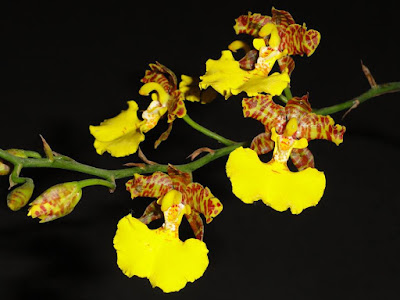Rhynchostele londesboroughianum is native to Mexico. This orchid occurs only in the State of Guerrero, where it grows at an altitude of 1000-1200 m above sea level...
Rhynchostele londesboroughianum also called as Londesborough's Rhynchostele, Amparoa londesboroughiana, Odontoglossum londesboroughianum, Mesoglossum londesboroughianum, is a species of the genus Rhynchostele. This species was described by Soto Arenas & Salazar in 1993.
IDENTIFY RHYNCHOSTELE LONDESBOROUGHIANUM
Rhynchostele londesboroughianum is native to Mexico. This orchid occurs only in the State of Guerrero, where it grows at an altitude of 1000-1200 m above sea level. These plants are found mainly in areas with diverse vegetation, and grow in full sun on the rocks of the eastern slopes. It happens to meet them sometimes growing epiphytically on pieces of wood or fallen logs on the surface of the ground.
It is a medium to large sized, cool to warm growing, lithophytic or terrestrial species, which reaching up to 56 cm in height, with ovoid, bilaterally compressed, olive green, 7.5 cm long and 4.5 cm wide pseudobulbs enveloped basally by 2 pairs of foliaceous sheaths and carrying 2 to 3 apical, linear-lanceolate, acute, up to 45 cm long and 4.5 cm wide leaves that are deciduous after flowering.
Londesborough's Rhynchostele flowers in the fall and has a basal, erect, to 180 cm long, racemose or few branched, 15 to 30 flowered, towards the apex inflorescence subtended by several sheaths and the long-lasting flowers are arranged alternately on the rachis, deciduous in late spring. The attractive, durable flowers are 3-5 cm in diameter. They are bright golden-yellow with concentric rows of red-brown spots, stripes or dots on the petals of both whorls and sometimes also on the base of the lip.
RHYNCHOSTELE LONDESBOROUGHIANUM CARE AND CULTURE
Cultural information should only be used as a guide, and should be to be adapted to suit you. Your physical location; where you grow your plants, how much time you have to devote to their care, and many other factors, will need to be taken into account. Only then can you decide on the cultural methods that best suit you and your plants.
Light:
Rhynchostele londesboroughianum needs a light level of 35000-50000 lux. It requires a very clear position. The plants easily adapt to full sun exposure in the morning, but light shading at midday may be beneficial. Strong air movement must be ensured at all times, which is especially important for plants growing in full sun.
Temperature:
It is a thermophilic plant. The average temperature of the day in summer 30-31 ° C, at night 19-20 ° C, which gives a daily difference of 11 ° C. In spring, the temperature during the day reaches 32-33 ° C, at night 16-19 ° C, and the daily difference is 15-16 ° C. In winter, the average day temperature is 29-31 ° C, night 13-14 ° C, with a daily amplitude of about 16 ° C.
Humidity:
Londesborough's Rhynchostele needs the average humidity of probably 75% for most of the year, falling slightly to 60-65% in winter and early spring.
Substrate, growing media and repotting:
The new growths are quite distant from each other on the rhizome, which makes Rhynchostele londesboroughianum easier to cultivate a cork or tree fern attached to the patch. However, such plants require high humidity and during the hot and dry weather it may be necessary to water several times a day.
The plants can also be grown in pots or baskets filled with a very loose, quickly drying base that allows the roots to dry quickly after watering. Some use a medium granulation cortex or chopped tree fern fibers and add some pearlite to improve the substrate's permeability and moisture retention. The addition of charcoal also improves the permeability of the substrate, and also protects against acidification. The soil around the roots must not be allowed to decompose or sag.
When we notice the beginning of the decomposition of the substrate, the plants should be repotted immediately. It's best to do it when new roots start growing. This makes it easier for plants to root in the shortest possible time.
Watering:
In the four to five months of the rainy season, which lasts from late spring to autumn, the precipitation is slight to moderate. Their number rapidly decreases in autumn, which is the beginning of the six-month period of winter drought. The cultivated plants should often be watered during active growth, but the roots must always dry quickly between watering. In the autumn, watering should be very limited.
Fertilizer:
During the active growth, the plants should be fertilized every week 1/4-1/2 of the recommended dose of fertilizer for orchids. You can use sustainable fertilizer throughout the year or use high-nitrogen fertilizer from spring to mid-summer, switching to high-phosphorus in late summer and autumn. After the leaves fall, which occurs in late summer or autumn, fertilization should be discontinued.
Rest period:
For 6-7 winter months, Rhynchostele londesboroughianum should be fogged from time to time and possibly slightly watered if the pseudobulbs start to wrinkle or show other disturbing signs. Fertilization should be eliminated until new growths appear and more watering begins in the spring. New increments may be susceptible to creasing, so be careful not to soak the green tips that appear, especially if the humidity is high, so slow evaporation.















COMMENTS